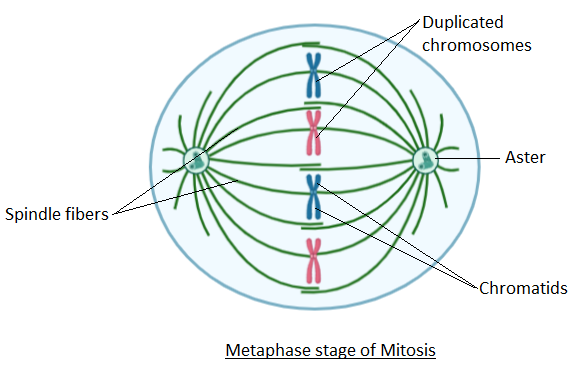
i) Draw a well-labelled diagram to show the metaphase stage of mitosis in an animal cell having four chromosomes.
ii) Mention any two reasons for the population explosion in India.
iii) Give biological reasons for the following.
1. The pituitary gland is also known as the master gland.
2. Gametes have a haploid number of chromosomes.
Answer
546.6k+ views
Hint: The metaphase stage of mitosis is represented by chromosomes lining up along the metaphase plate. Population explosion is the uncontrolled growth of the population. The pituitary gland is situated in the brain and secretes regulatory hormones. Gametes are the result of the reductional division.
Complete answer:
i) Mitosis is one of the two cell divisions that occur in living organisms. Mitosis results in the formation of two daughter cells from one mother cell. The mother genome gets duplicated into two and is transferred to each of the daughter cells individually. Mitosis occurs in four phases. The first phase is the prophase, marked by chromatin condensation. The second phase is marked by the lining of a duplicated genome or chromosomes along an equatorial plate called the metaphase plate. This stage is called the metaphase. Anaphase is the third phase marked by the separation of sister chromatids in the opposite direction. The last stage is telophase where two distinct nuclear membranes appear around separated sister chromatids.
ii) Population explosion is a term referred to as uncontrolled growth in population. In India, a population explosion occurs mainly due to two reasons. The first reason is the desire of the male child by parents. The second reason is the lack of awareness regarding birth control measures.
iii) The pituitary gland is a small bean-shaped gland situated in the centre of the brain. It secretes several regulatory hormones that control the secretion and function of other hormones. As a result of which, it is called the master gland.
iv) Gametes are the result of reductional division called meiosis. Meiosis is characterized by a reduction in the number of chromosomes. So, the number of chromosomes gets half in the daughter cells. It makes daughter cells or gamete cells haploid. These haploid gametes fuse to form a diploid zygote during fertilization to re-establish the normal number of chromosomes.

Note: Pituitary hormones play a vital role in the regulation of gamete formation. The mother gamete cells follow meiosis to make daughter gamete cells. Meiosis involves crossing over of genes which results in variation in the zygote.
Complete answer:
i) Mitosis is one of the two cell divisions that occur in living organisms. Mitosis results in the formation of two daughter cells from one mother cell. The mother genome gets duplicated into two and is transferred to each of the daughter cells individually. Mitosis occurs in four phases. The first phase is the prophase, marked by chromatin condensation. The second phase is marked by the lining of a duplicated genome or chromosomes along an equatorial plate called the metaphase plate. This stage is called the metaphase. Anaphase is the third phase marked by the separation of sister chromatids in the opposite direction. The last stage is telophase where two distinct nuclear membranes appear around separated sister chromatids.
ii) Population explosion is a term referred to as uncontrolled growth in population. In India, a population explosion occurs mainly due to two reasons. The first reason is the desire of the male child by parents. The second reason is the lack of awareness regarding birth control measures.
iii) The pituitary gland is a small bean-shaped gland situated in the centre of the brain. It secretes several regulatory hormones that control the secretion and function of other hormones. As a result of which, it is called the master gland.
iv) Gametes are the result of reductional division called meiosis. Meiosis is characterized by a reduction in the number of chromosomes. So, the number of chromosomes gets half in the daughter cells. It makes daughter cells or gamete cells haploid. These haploid gametes fuse to form a diploid zygote during fertilization to re-establish the normal number of chromosomes.

Note: Pituitary hormones play a vital role in the regulation of gamete formation. The mother gamete cells follow meiosis to make daughter gamete cells. Meiosis involves crossing over of genes which results in variation in the zygote.
Recently Updated Pages
Master Class 11 Economics: Engaging Questions & Answers for Success

Master Class 11 English: Engaging Questions & Answers for Success

Master Class 11 Social Science: Engaging Questions & Answers for Success

Master Class 11 Biology: Engaging Questions & Answers for Success

Class 11 Question and Answer - Your Ultimate Solutions Guide

Master Class 11 Business Studies: Engaging Questions & Answers for Success

Trending doubts
10 examples of friction in our daily life

One Metric ton is equal to kg A 10000 B 1000 C 100 class 11 physics CBSE

Difference Between Prokaryotic Cells and Eukaryotic Cells

1 Quintal is equal to a 110 kg b 10 kg c 100kg d 1000 class 11 physics CBSE

State the laws of reflection of light

Explain zero factorial class 11 maths CBSE




